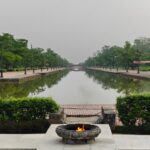Following the protests of Madhes-based parties over different provisions in the new constitution, economic activity in the city of Birgunj was brought to a complete halt with businesses being shutdown for up to 9 hours a day for nearly six months. Post promulgation of the constitution, the strikes manifested itself as border obstructions, severely halting the movement of goods to and from India. Cargo movement was fairly normal prior to promulgation of the constitution, as despite the strikes in the area trucks would be escorted by security forces. However this changed quickly after.
Up until Chatth Parva, a majority of the Madhes populace participated in these protests, with many coming to Birgunj from the adjoining villages in a show of solidarity. However, enter harvest season, a significant portion of the protestors returned to their villages and the protests waned. Some also allege that a sense of fatigue had set in among the politicians by this time. Nonetheless, the protests continued effectually, halting the operation of industries, corporations and local businesses bringing the mainstream Birgunj economy to a standstill. On the other hand, this quickly gave way to black marketing of fuel and other essentials as also seen in other parts of the country.
Desolate markets: During the blockade, businesses in Birgunj; especially in and around the marketplace, remained shut in the peak hours of 9am to 5pm. Local businesses that thrived on the movement of people and goods across the borders reported heavy fall in sales as protestors closed down the area for a significant portion of the day leaving only a small window of time for market transactions. Within this timeframe, the locals and enterprises got some respite; while workers dependent on daily wage like rickshaw and cart pullers could make few earnings. Nonetheless, the flow of goods across the border remained at a standstill and big industries along the Birgunj-Simara-Hetauda stretch struggled to maintain operations as the cost of production kept rising due to shortage of fuel and raw materials. Similarly, daily wage workers such as rickshaw pullers and cargo loaders found it impossible to sustain livelihoods during the blockade. With no avenues for regular income coupled with rising costs, some individuals were compelled to survive on little savings that they managed to accumulate over the years, informal trade of fuel, or go back to their respective villages.
Birgunj also caters to a significant number of customers from beyond the border who mostly seek Chinese electronics and apparels. While protests at border-points are clearing up, these local businesses have yet to show signs of recovery, as the inflow of Indian nationals continue to remain low.
Raxual loses steam: Businesses in Raxaul, the Indian side of the border, witnessed significant thinning in sales with a decline in Nepali shoppers (except for the locals residing in Birgunj who knew their way around the border). Outlets such as apparel shops and kitchen appliance stores, which the Nepali shoppers primarily access, marked significant drops in sales, with some reporting decline of about 70%. This decline was especially notable for apparel shops as the blockade occurred during the peak wedding season; wherein a single set of customers would normally buy products worth approximately NPR 500,000.Meanwhilewholesale sales stalled completely.
Opportunistic measures: While the blockade severely affected most businesses and livelihoods, it also proved to be an opportune moment for a few others. Apart from smuggling fuel, the trend of running informal transport services along the highway proliferated where individuals with two-wheelers charged exorbitant prices to anyone wanting to travel from point A to B; a distance of less than 30 km reportedly cost around NPR 300, while a trip of roughly 110-120 km could cost over NPR 10,000.Locals allege these informal transporters to also be involved in fuel peddling; one account of the incident involved a peddler making up to NPR 1.7 million during the course of the blockade. With limited transport services and high informal transport prices, travelers rather opted for Indian routes to travel along the plains.
Limping back again: Birgunj’s economy has slowly begun to show signs of revival following the blockade. Unlike after the first Madhes movement when armed groups mushroomedthreatening the Birgunj economy to the extent where investors, enterprises, and workers diverted to seek opportunities beyond the border, the situation does not appear discouraging to such an extent this time around. Especially with the provisions set up by NRB regarding concessions on loans and waivers in interest, individuals and businesses have been given a room to breathe. Tension surrounding the border has quelled for now and although most still maintain that the political feud is bound to continue till a concrete settlement is agreed upon, the possibility of another blockade, with suspicion of involvement of the Indian government, appears to be a distant reality.
However, lifting of the blockade must not be regarded as a victory by the government; considering the whole blockade ordeal as a duel between the government andagitating parties is a fallacious standpoint. Only after a sustainable settlement to contentious political disagreements is found, can Birgunj and the entire region’s economy—which holds much promise—brace for growth. For this it is imperative that both sides find amicable and mutually acceptable solutions as soon as possible.
Note: This neftake is based on conversations with businesspersons, journalists, rickshaw drivers, local residents of Birgunj and Raxaul, and documents their opinion on the impacts of the blockade on their economy.





